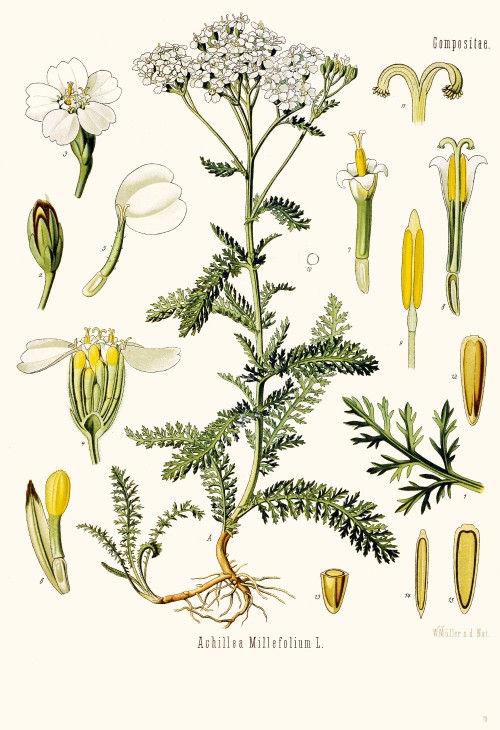Dies ist eine alte Version des Dokuments!
Achillea millefolium L. - Asteraceae - common yarrow, milfoil, woundwort, bloodwort, tansy, Gemeine Schafgarbe, Wiesenschafgarbe
Aromatic rhizomatous perennial, native to Europe, West Asia, North America; 0.20-0.80m high, stems simple or branched; leaves pinnately dissected, the blade 3-15 cm, to 2.5 cm wide, the basal petiolate, all but the lowermost cauline sessile; heads numerous in a flat or round-topped, short and broad, paniculate-corymbiform inflorescens, the disk 2-4 mm wide; ray flowers about 5, white or occasionally pink, 2-3 mm; disk-flowers 10-30; various habitats, but especially in disturbed sites; circumboreal; fl. time June-Nov.
The group includes several varieties and subspecies like:
Achillea millefolium var. collina Becker ex Wirtg. = Achillea collina (Becker ex Wirtg.) Heimerl - Europe, Hügel-Schafgarbe (german)
Achillea millefolium subsp. millefolium - Europe, Asia
Achillea millefolium subsp. borealis (Bong.) Breitung = Achillea borealis Bong. - arctic regions
Achillea millefolium var. alpicola; var. californica; var. occidentalis; var. pacifica; var. puberula - North America
https://en.wikipedia.org/wiki/Achillea_millefolium
The air-dried aerial parts of Achillea millefolium (yarrow, milfoil, Millefolium, Herba millefolii, Millefolii Herba, Schafgarbenkraut), gathered during the flowering period from June to September, have been used for a long time: The Greek hero Achilles (ca. 1200 B.C.) is said to have used the leaves to stop the bloodflow of his wounded soldiers. The drug got mention in numerous of the great herb books of the Middle Ages.
Yarrow contains flavanoids, tannin, chamazulenogenic compounds, volatile oil (0.1-1%) and a bitter principle.
[BHP83, Wichtl, BI, CRC]
The drug is said to act spasmolytic, antiseptic, astringend. Said to be diaphoretic, antipyretic and hypotensive. It is used internally to treat inappentence, dyspeptic disorders, slight gastrointestinal spasms. BHP83 states the indications „fevers, common cold, hypertension“ among others, according to the claimed diaphoretic, antipyretic and hypotensive action. Externally as sitting bath to treat Pelvipathia vegetativa (painful spasms of the female pelvis with psycho-vegetative origin), tincture or liquid extract to treat wounds and inflammation of the skin. [BHP83]
The German Commission E a therapeutic guide to herbal medicine, approve mifoil to treat inappentence, dyspeptic disorders, and slight gastrointestinal spasms orally, and as sitting bath to treat Pelvipathia vegetativa.
[Bundesanzeiger: 1.2.1990., Heftnummer: 22a., ATC-Code: A15. Monographie BGA/BfArM (Kommission E)] http://buecher.heilpflanzen-welt.de/BGA-Kommission-E-Monographien/achillea-millefolium-schafgarbe.htm
Only the tetraploid species produce blue oils on steam distillation, indicating the presence of proazulenes in the herb. The proazulene biotype was represented by tetraploid species (In = 36, A.collina Becker from Ukraine and A. asiatica Serg. from Moscov) and the nonazulene type by the hexaploid species A. millefolium L. (In = 54).
[Korrelation zwischen Chromosomenzahl und Prochamazulenen in Achillea von Osteuropa.(Correlation between number of chromosomes and prochamazulene in easteuropean Achillea)., Oswiecimska, M., Planta Med., 25(4), 1974, 389-395]
It has been stated that the guaianolid α-peroxyachifolid is responsible for the allergic contact dermatitis caused by yarrow.
[Ruecker G, Manns D, Breuer J, Arch. Pharm. (Weinheim, Ger.) 324(12) (1991), 979-81]
Analysis of the volatile oil of Achillea millefolium plants growing wild in Greece showed the main constituents to be 1,8-cineole, camphor, borneol and lavandulol. A comparison of the main volatile constituents revealed that great infraspecific variation occurs.
[Kokkalou E, Kokkini S, Hanlidoe E, Biochem. Syst. Ecol. 20(7) (1992), 665-70]
The flower heads of A.millefolium var. collina contain several individual sesquiterpene lactones, including some proazulenic guaianolides (artabsin-, achillicin- and matricine derivatives eg.).
[Sesquiterpene lactones from Achillea collina J. Becker ex Reichenb., Trendafilova, A., Todorova, M., Mikhova, B., Vitkova, A., Duddeck, H., Phytochemistry, 67(8), 2006, 764-770]
„… flowering aerial parts of wild Achillea millefolium growing on the Mediterranean coast (Sardinia Island, Italy) and on the Atlantic coast (Portugal- Serra de Montemuro) were used as a matrix for supercritical extraction of volatile oil with CO2 (SFE)…. The results showed the presence of two type oils. The Italian volatile extracts (SFE and essential oil) are predominantly composed by α-asarone (25.6-33.3%, in the SFE extract and in the HD oil, respectively), β-bisabolene (27.3-16.6%) and α-pinene (10.0-17.0%); whereas the main components of the Portuguese extracts are trans-thujone (31.4-29.0%), trans-chrysanthenyl acetate (19.8-15.8%) and β-pinene (1.2-11.1%).“
[Chemical composition and biological activity of the volatile extracts of Achillea millefolium., Falconieri, D., Piras, A., Porcedda, S., Marongiu, B., Gonçalves, M.J., Cabral, C., Salgueiro, L., Natural product communications, 6(10), 2011, 1527-1530]
The yields of oil in 14 commercial samples of yarrow ranged from 0.1%-1.0% (12 samples were in accordance with the European Pharmacopoeia requirements, demanding not less than 0.2%). The most important components of the oils were chamazulene (0.8-44.3%), β-pinene (tr-23.3%), sabinene (0-16.5%), bornyl acetate (tr-15.8 %), (E)-β-caryophyllene (2.5-14.3%), (E)-nerolidol (tr-9.6 %), 1,8-cineole (tr-9.6 %), and germacrene D (0.2-7.8 %).
[Essential oil content and composition in commercial Achillea millefolium L. herbs from different countries., Raal, A., Orav, A., Arak, E., Journal of Essential Oil Bearing Plants, 15(1), 2012, 22-31]
In a randomized controlled trial, 56 cancer patients with chemotherapy-induced oral mucositis (OM), „… the experimental group gargled 15 mL of a mixture of routine solution and distilled A. millefolium 4 times a day for 14 days while the control group gargled 15 mL of routine solution. The severity of OM was assessed at three times before, 7 and 14 days after intervention. The mean severity score was 2.39 ± 0.875 in both groups at start of the study that was changed to 1.07 ± 0.85 and 0.32 ± 0.54 in the intervention group in days 7 and 14 (p < 0.001). However, the severity of OM was increased to 2.75 ± 0.87 and 2.89 ± 0.956 in the control group respectively (p < 0.001)… A. millefolium distillate healed oral mucositis much more than the routine solution.“
[Miranzadeh, S., Adib-Hajbaghery, M., Soleymanpoor, L., & Ehsani, M. (2015). Effect of adding the herb Achillea millefolium on mouthwash on chemotherapy induced oral mucositis in cancer patients: A double-blind randomized controlled trial. European Journal of Oncology Nursing.]

Köhler,F.E., Medizinal Pflanzen, vol.1 t.70 (1887) [W.Müller]
http://plantgenera.org/species.php?id_species=11698
